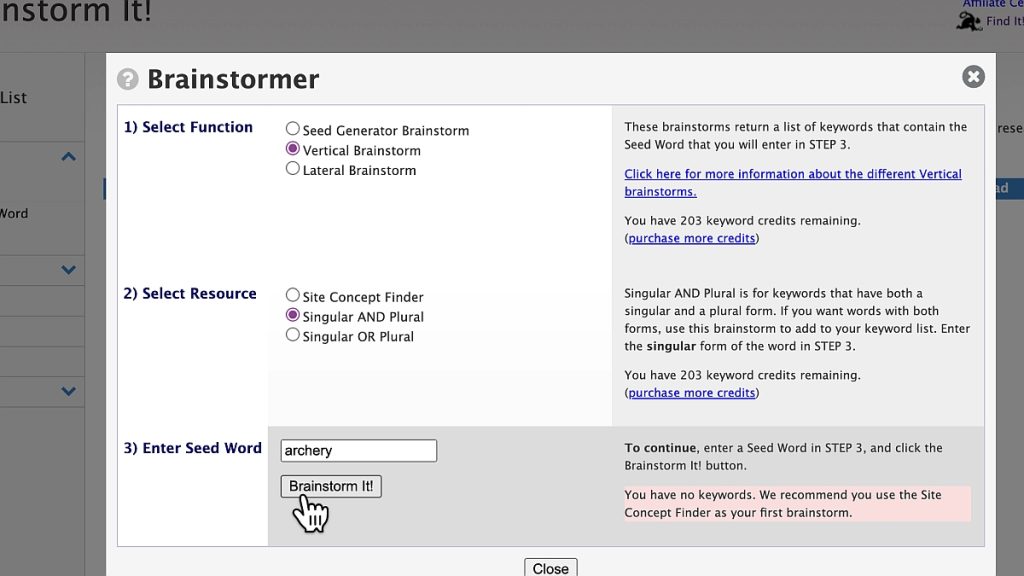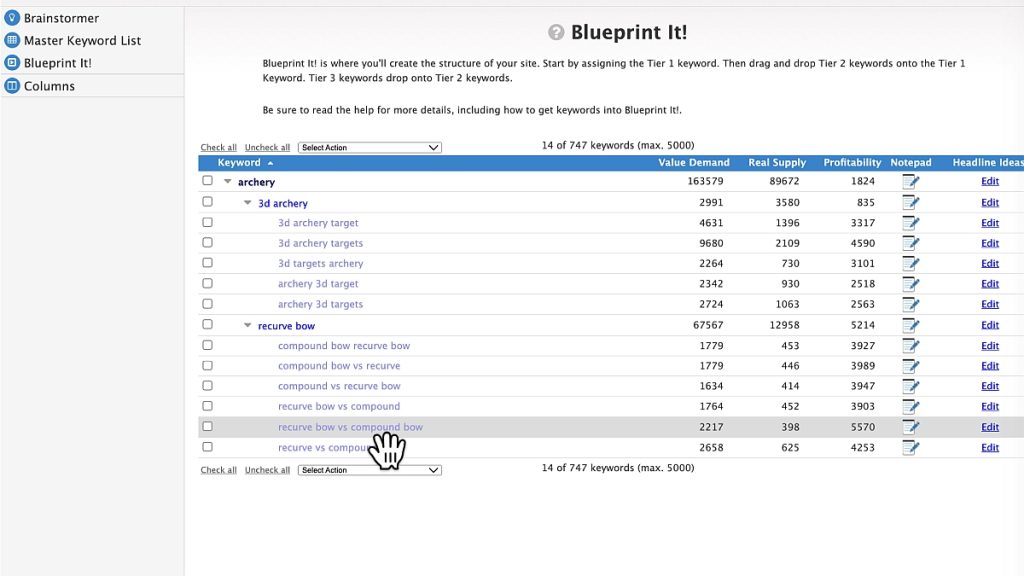
Beginning the journey of creating a niche website can be both exciting and daunting.
This smart keyword research tutorial using tools like SBI!’s “Brainstorm It!” and “Blueprint It!” can simplify the process for you. They guide you from the brainstorming phase to the creation of a structured site blueprint.
Let me demonstrate how to leverage these tools effectively.
Keyword Research Tutorial Step 1: Kickoff with Brainstorm It!
Brainstorm It! is your first port of call. This tool which is integral to SBI! and SBI! for WP is designed to help you uncover valuable keywords related to your niche, providing insights into demand, supply, and potential profitability.
Let’s say your passion project revolves around archery. You aim to build a site that not only shares your journey to the Olympics but also educates beginners aspiring to reach professional levels.

Brainstorm It! offers different types of brainstorms. For my example, I am doing a vertical brainstorm with the seed word “archery.”
- Start Broad, then Narrow Down: Begin with general keywords related to your niche, like “archery.” This broad approach helps you capture a wide array of related terms. However, it’s crucial to refine these keywords to ensure relevance and manageability.
- Refine Your Keywords: Identify and eliminate overly general keywords. For example, “target” might bring up unrelated results. Instead, focus on more specific terms like “archery target” to maintain niche relevancy.
- Explore Specific Aspects: Dive into particular areas within your niche. If you’re focusing on a specific type of archery, like using a recurve bow, use this term for a more targeted brainstorming session. This approach helps you discover keywords with less competition, making it easier to rank in search engine results.
Watch this one minute video to see Brainstorm It! in action.
Keyword Research Tutorial Step 2: Transition to Blueprint It!
With a refined list of keywords, it’s time to structure your site using Blueprint It!. This tool allows you to organize your keywords into a coherent website architecture. It helps you visualize the layout of your content, similar to a mindmap.

The image shows how you’d develop the structure for a niche website about archery with Solo Build It!’s Blueprint It! tool.
-

save pin for later 👆 Identify Your Audience: Understanding who you’re writing for is crucial. If your target audience is beginners with aspirations to go professional, your content should reflect this journey. Use your experiences and the questions you had when starting out as a guide for your content.
- Structure Your Site: Begin by selecting a broad, brandable term for your site concept. Then, create tiered categories (Tier 2) and subcategories (Tier 3) based on your keywords. For example, “Recurve Bow” could be a Tier 2 category with several Tier 3 pages discussing different aspects, such as “Choosing a Recurve Bow” or “Recurve Bow Techniques.”
- Content Planning: Use your blueprint as a roadmap for content creation. Start with less competitive keywords to build authority and gradually tackle more competitive terms. This strategic approach helps you grow your site’s visibility and authority over time.
- Evaluate and Adjust: Your site’s blueprint is not set in stone. As you create content and learn more about your audience’s needs and pain points, be prepared to adjust your plan. Adding new categories or refocusing existing ones is part of the evolving nature of a successful niche site.
See how Blueprint It! helps you organize your content in this short video.
Practical Tips for Niche Website Success
By following this keyword research tutorial and leveraging “Brainstorm It!” and “Blueprint It!,” you’re well on your way to building a niche site that not only ranks well in search engines but also genuinely connects with your audience.
I’d like to finish my short keyword research demonstration with three additional tips to make your site successful:
Use Tools Like “Answer The Public“: This can provide insights into the questions your audience is asking, helping you create content that directly addresses their needs.
Focus on Quality and Relevance: Always prioritize creating content that is both informative and engaging. Your goal is to become a trusted resource in your niche.
Monitor Your Progress: Regularly review your site’s performance using analytics tools (e.g. Google Analytics). This data can guide your content strategy and site adjustments.
Remember, the journey of creating a profitable site is a marathon, not a sprint. Patience, persistence, and continuous learning are your best allies.
Solo Build It! includes everything you need
to take you from idea to income.
For just $1 a day.

Carol Leather
Latest posts by Carol Leather (see all)
- How Do I Plan a Successful Website Before Building It? - December 5, 2024
- 7 Lessons Pet Ownership Can Teach You About Business - June 20, 2024
- How to Humanize AI Content: Go Beyond the AI Buzzwords - May 30, 2024

